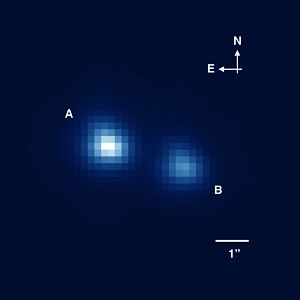EBLM J0555-57
Triple star system in the constellation Pictor From Wikipedia, the free encyclopedia
EBLM J0555-57 is a triple star system approximately 670 light-years from Earth. The system's discovery was released on July 12, 2017. EBLM J0555-57Ab, the smallest star in the system, orbits its primary star with a period of 7.8 days, and currently is the smallest known star with a mass sufficient to enable the fusion of hydrogen in its core.
 Resolved image of EBLM J0555-57A (left) and EBLM J0555-57B (right) taken with the Leonhard Euler Telescope at the ESO's La Silla Observatory[1] Credit: ESO | |
| Observation data Epoch J2000 Equinox J2000 | |
|---|---|
| Constellation | Pictor |
| EBLM J0555-57A | |
| Right ascension | 05h 55m 32.6885s[2] |
| Declination | −57° 17′ 26.067″[2] |
| Apparent magnitude (V) | 9.98[1] |
| EBLM J0555-57B | |
| Right ascension | 05h 55m 32.3944s[3] |
| Declination | −57° 17′ 26.748″[3] |
| Apparent magnitude (V) | 10.76[1] |
| Characteristics | |
| EBLM J0555-57A | |
| Spectral type | F8[4] |
| Variable type | Eclipsing[1] |
| EBLM J0555-57B | |
| Spectral type | G0V[citation needed] |
| Astrometry | |
| EBLM J0555-57A | |
| Radial velocity (Rv) | 18.66±0.74[5] km/s |
| Proper motion (μ) | RA: 2.972[2] mas/yr Dec.: −39.532[2] mas/yr |
| Parallax (π) | 4.8611±0.0137 mas[2] |
| Distance | 671 ± 2 ly (205.7 ± 0.6 pc) |
| EBLM J0555-57B | |
| Proper motion (μ) | RA: 2.838[3] mas/yr Dec.: −38.344[3] mas/yr |
| Parallax (π) | 4.8747 ± 0.0175 mas[3] |
| Distance | 669 ± 2 ly (205.1 ± 0.7 pc) |
| Position (relative to A) | |
| Component | B |
| Epoch of observation | 1998 |
| Angular distance | 2.50″ [4] |
| Position angle | 254° [4] |
| Projected separation | 479 AU [1] |
| Orbit[1] | |
| Primary | Aa |
| Companion | Ab |
| Period (P) | 7.757676+0.000029 −0.000025 d |
| Semi-major axis (a) | 0.0895+0.0018 −0.0019 au |
| Eccentricity (e) | 0.0894+0.0035 −0.0036 |
| Inclination (i) | 89.3+0.9 −1.1° |
| Argument of periastron (ω) (secondary) | −53.7+1.5 −1.8° |
| Details[1] | |
| EBLM J0555-57Aa | |
| Mass | 1.180+0.082 −0.079[6] M☉ |
| Radius | 1.00+0.14 −0.07[6] R☉ |
| Luminosity | 3.245[7] L☉ |
| Surface gravity (log g) | 4.10±0.21[6] cgs |
| Temperature | 6,368±124[6] K |
| Metallicity [Fe/H] | −0.24±0.16[1] or −0.04±0.14[6] dex |
| Rotation | 6.92±1.61[6] days |
| Rotational velocity (v sin i) | 7.60±0.28[1] km/s |
| Age | 1.6±1.2[6] Gyr |
| EBLM J0555-57Ab | |
| Mass | 0.0839±0.0038[6] M☉ |
| Mass | 87.9±4.0[6] MJup |
| Radius | 0.0844+0.0131 −0.0060[6] R☉ |
| Radius | 0.82+0.13 −0.06[6] RJup |
| Surface gravity (log g) | 5.51+0.06 −0.12[6] cgs |
| EBLM J0555-57B | |
| Mass | 1.01[8] M☉ |
| Radius | 0.94±0.08[1] R☉ |
| Luminosity | 1.501[9] L☉ |
| Surface gravity (log g) | 4.37[8] cgs |
| Temperature | 5,717±124[1] K |
| Metallicity [Fe/H] | −0.38[8] dex |
| Other designations | |
| CD−57 1311, CPD−57 913, WDS J05555-5717, TYC 8528-926, 2MASS J05553262-5717261 | |
| Database references | |
| SIMBAD | data |
System

EBLM J0555-57, also known as CD−57 1311, is a triple star system[1][10] in the constellation Pictor, which contains a visual binary system consisting of two sun-like stars separated by 2.5": EBLM J0555-57Aa, a magnitude 9.98 spectral type F8 star, and EBLM J0555-57B, a magnitude 10.76 star. No orbital motion has been detected but they have almost identical radial velocities and are assumed to be gravitationally bound.[1]
Component A of the system is itself an eclipsing binary (EBLM J0555-57Ab orbiting EBLM J0555-57Aa). Eclipses, also known as transits in the context of planetary searches, have been detected in the near infrared, with brightness drops of 0.05% during the eclipse. The shape and duration of the transits allow the radii of the two stars to be determined. A full solution of the orbit gives a period of 7 days and 18 hours, with a low eccentricity of 0.09, an almost edge-on inclination of 89.84°, and a semi-major axis of 0.08 AU.[1]
EBLM J0555-57Ab
EBLM J0555-57Ab has a mass of about 88±4 Jupiter masses, or 0.084 solar masses. Its radius is 0.084 solar radii (about 59,000 km), comparable to Saturn, which has an equatorial radius of 60,268 km. The star is about 290 times more massive than Saturn.[6] Current stellar models put its mass at the lower limit for hydrogen-burning stars. EBLM J0555-57Ab was discovered by a group of scientists at the University of Cambridge associated with the EBLM project (Eclipsing Binary, Low Mass),[1] using data collected by the WASP project. WASP (Wide Angle Search for Planets) is searching for exoplanets using the transit method. [11] The findings were released on July 12th, 2017, though the exact date of the discovery is unknown. Additional properties of the star were determined using Doppler spectroscopy, to measure the periodic radial velocity variation of the primary star due to the gravitational influence of its companion.[1]
Wikinews has related news:
EBLM J0555-57Ab is the smallest hydrogen burning star currently known.
See also
- 2MASS J0523−1403
- OGLE-TR-122 - This binary stellar system contained one of the smallest red dwarfs known when it was discovered.
- OGLE-TR-123
- TRAPPIST-1
- SSSPM J0829-1309
- GJ 1245
- List of smallest stars
References
External links
Wikiwand - on
Seamless Wikipedia browsing. On steroids.
